
ChatGPT in Recruitment: How to Unlock its Power & Increase Efficiency
Curious about how to use ChatGPT in recruitment? To dive into game-changing sourcing and recruiting practices using AI, Talk Talent to Me went live with these top leaders in New York and San Francisco:
- Director of Talent Sourcing, Activision Blizzard, Justin Ghio
- VP of Talent and Culture, Humane, José Cong
- Director, Talent Acquisition, Employer Branding & Awareness, PandoLogic, Jenny Cotie Kangas
- Chief Technology Officer, Hired, Dave Walters
Time is precious so we’re sharing the top tactics from the workshops so you can start cutting down on time-consuming, redundant tasks. This frees you up to focus on what’s most important – the human-centric aspects of recruiting that maximize impact.
Need to get started ASAP? Get straight to our free template with the top tech candidate personas and resources for crafting your ideal outreach sequences!
Change your approach: speed > experienceJosé Cong suggests taking on an analytical perspective. Earlier this year, he did an A/B test with his team. “A” was his most experienced recruiter with over 25 years of experience. “B” was a coordinator he coached on using ChatGPT in recruitment. Five months later, “B” was outperforming the recruiting veteran at a 3X pace.
The team even recently closed their first two principal-level engineers (the highest level you can get as an IC). To him, that was not a coincidence. He saw a pattern.
José’s coordinator was taking his guidance a step further, dropping in the resume, job description, and manager notes into ChatGPT. He asked the tool for guidance on how to approach and hold a conversation. It was working.
Related: AI Leads to More Human-Centric Recruitment & Hiring (What!?)
Augmented over artificial
This experience reinforced to José that AI was trainable. In fact, he says, “I hate the terminology ‘artificial intelligence.’ It’s augmented intelligence. If we think about it from that perspective, we’ll be less intimidated by it and more open-minded. This will allow us to do what we do best. We’re in the people business. Our job is not to write a great email or come up with a list of candidates if we get to a place where we are recognizing great talent.”
José believes talent teams now have the ability to craft a message so individuals see something different than what they’re getting and it makes them stop. He calls it the “aha moment.”
Focus on relationship-building
To José, the challenge is getting to that “aha” email. He says, “How do we personalize it? How do we make it representative of our brand? How do we figure out the best way to make that connection? And once we do that, how do we initiate the conversation? Once we have them on the phone or on video, that’s the feature allowing us, as recruiters, to not waste months trying to figure out how to become an expert in a subject we don’t know.
For a recruiter, it’s not about how many candidates you get through or how many closes. We judge ourselves in terms of the quality of people.”
He wants recruiters to spend time developing relationships instead of searching mindlessly through LinkedIn. A tool like ChatGPT in recruitment handles the remedial work that will eventually burn us out.
ChatGPT in recruitment tasks action: Intake to emailActing as a new recruiter, Justin Ghio demonstrates how to use ChatGPT in recruitment to:
- Get closer to knowing what good looks like
- Build trust with a hiring manager
- Sound like a quality recruiter to a candidate (in a job field you may know nothing about!)
What ten questions should I ask a hiring manager about this role?
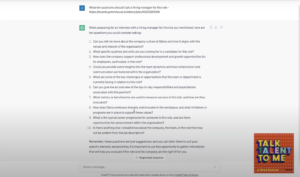
Linking to a job description for a Director of Product, Justin asks ChatGPT what ten questions to ask a hiring manager for the role. He points out the results are cookie-cutter questions. So, the next step is to make these more product-focused. He says, “This is where you can really see the power of it.
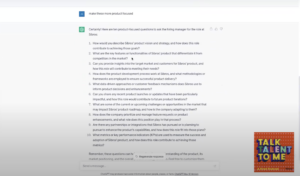
This AI technology is not output-based. It’s input-based. We are always going to be the input to make this technology powerful. Don’t be scared that it’s going to take your job. You are the key that unlocks its potential.”
Now, with these 10 questions, you might go into the intake meeting and get all the answers. But, you still don’t know much about this rec.
Hiring managers want to know: Do you know about this role? Can you sell it to candidates?
Write me a Boolean string.

Again, tailor it to the role:

Justin doesn’t recommend copying this output and launching it into LinkedIn, a CRM, or an ATS. Instead, he considers it a solid starting point.
“At Activision Blizzard, we work off buckets to create booleans. This gives you the ability to extend and find candidates quickly. Everything you know about [the company] and everything you learned from the hiring manager based on the questions you got, you then superimpose on the search to continue making it compelling.”
Then, you might take a deeper dive into who your company is up against.
What companies are the main competitors?
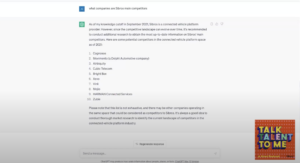
Use ChatGPT in recruitment to write a candidate a compelling email
By now, you’ve:
- Completed the intake meeting and have good notes.
- Acquitted your target and know what good looks like
- Evaluated core competitors
Next, it’s time for outreach. Justin requests a compelling email to a potential candidate.
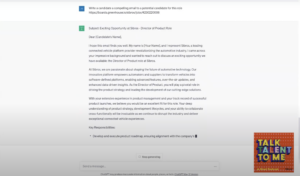
The result is a standard email but Justin wants you to ask yourself: How many quality pieces of iteration can I get done in the next five minutes?
Again, ChatGPT offers a starting point. Justin explains it isn’t about getting an entire email. “Maybe it’s to get the first four sentences, the hook, or a good subject line.”
Next, he requests something more interesting and creative.
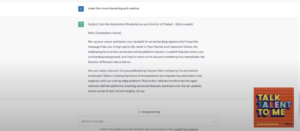
“For [Activision Blizzard], which is in the creative space, this is where we see the dividends pay off because the verbiage will change thematically.”
From here, continue optimizing.
Make it more concise.

Justin tells his team, “If you copy and paste this, then send it out, you’ll get a meeting from me on your calendar. But if you’re using bits and pieces, it will help accelerate.
Again, in the creative space, it’s really hard to come up with compelling messages for game developers and figure out what will stick. We have to use [tools] to give us a leg up.”

Justin praises how ChatGPT “points out the key responsibilities, which are parlayed from the job description we fed it. This is extremely helpful and saves time. It allows us to show up to the first meeting with a good candidate instead of making it a two-week process.”
Using AI and ChatGPT in recruitment in an equitable wayEstablish guidelines
Justin explains that at Activision Blizzard, AI is “never a decisive step. It is only a guide. We believe any system we have that has automation doesn’t use any simplified output as a determinant factor. It uses it as an indicative factor.
It is not deciding anything, but simply giving us inference and the ability to iterate and ideate quicker. There’s power in the ability to draw inferences from candidates.”
Justin offers further insight with this scenario:
“We are familiar with the DEI statistics about candidates not applying for a job when they don’t meet 100% of the qualifications. Let’s take the flip side of this as an example. Let’s say Person A didn’t add technology to their resume because they used it in one project. But their peer, Person B, wrote it on their resume. We can discover, because of AI, there’s a correlation and you should ask Person A about the technology Person B included on their resume.
It’s giving that inference to make an even better call. That could be the missing link between an instant reject and a potential hire.”
Justin believes the best results come from following guidelines around ChatGPT in combination with your “personal flair and stylistic input.”
Be intentional
In the case that AI does have some evil in it, José and his team “go out of [their] way to make sure [they] are investing time and effort into cycling through various demographics. I think that is the best of both worlds. You’re hopefully automating something that will take away the unconscious biases.
Just in case it wasn’t untrained with AI, you have to be intentional about making sure you’re targeting underrepresented individuals. The best thing is you can do it at a much higher rate.”
Use a bias checker
Jenny Cotie Kangas points out that generative AI is trained on everything from the Internet before 2021. She says, “If you’re using it for content generation, it’s really important to have a bias checker like Textio to make sure you’re not biased against people at scale.”
Tip: Install WebChatGPT, an extension allowing you to integrate post-2021 information into ChatGPT searches.
A CTO’s take on ChatGPT in recruitment and otherwise
Hired CTO, Dave Walters sees his team using ChatGPT more and more. He says, “We’re finding more opportunities to leverage it and make our lives more efficient. I embrace it.”
That’s not without caution though.
At Hired, Dave and his team are trying to “get ahead by setting policies and procedures for when it should and shouldn’t be used, and what you should and should not do with it.
I recommend getting policies in place so teams know what to do and what not to do. Don’t let that policy be ‘don’t use it.’ You will fall behind. It’s inevitable. People will use it anyway so find the safe ways to implement it and the ways that will benefit your employees, team members, and company.”
ChatGPT prompt ideas for talent professionalsHow else can ChatGPT help talent pros? Just ask it! Jenny says, “You can ask generative AI to be your consultant to help you figure out where you can use it.” Here’s a simple example for talent acquisition leaders:

“I have ChatGPT build my project plans for how I handle the day. If I need to respond to an email, I can take the email and ask it to draft a response.”
Write a better business case
Bring ChatGPT a specific situation. Let’s say you’re not getting the candidates you need from your job board advertising. If you need to request more budget, Jenny recommends developing a use case by asking ChatGPT to help you write a compelling argument.
Support your talent acquisition strategy
Legislation changes quite often and talent professionals need to stay in the loop to optimize their TA strategy. Jenny explains, “The Colorado Equal Pay Act says to put pay and benefits on a job advertisement. If I’m looking at that with my talent acquisition strategy as just Colorado, I’m missing the bigger picture. Take the block of information about the Colorado Equal Pay Act and take CCPA and New York’s Local Law 144.
Then, ask ChatGPT to give the meta implications of these laws to scale that instead of looking at the tiny aspect of a specific piece. That is what we should be using to build talent strategies.”
Sharp vs non-sharp questionsNow that you have some questions to ask, let’s cover how to ask AI effectively. Jenny emphasizes, “You have to ask the right, sharp question to get the answer.” Here’s her example:
“What is AI?”
This is a non-sharp question, which will just present a broad response not specific to your individual use case. “Think of generative AI as having all the hats. To get it to respond more precisely, you want to call out the specific hat you need it to wear.”
This is what Jenny considers a sharp question, modified to be specific for a stronger output:
“As a Talent Acquisition leader considering leveraging ChatGPT in recruitment in my day-to-day, what are some things I should consider choosing to begin?”
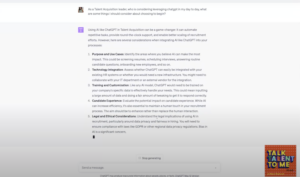
revised 19 July 2023
Related blog posts

How to Use AI in Recruitment: Insights from Activision Blizzard’s Talent Sourcing Director
Artificial Intelligence, or AI, is taking every industry by storm and tech recruiting is no...

Early Career Hiring, Using AI in Recruitment, & More: Talk Talent to Me June ’23 Recap
Catch up on the June 2023 episodes of Hired’s Talk Talent to Me podcast featuring recruiting and...

How to Manage Inbound Applications & Rethink Talent Sourcing Analytics: Tips for Recruiters
Experiencing an overwhelming volume of inbound applications? In a new episode of Talk Talent to...

Investing in Early Talent, Relearning, & More: Talk Talent to Me April ’23 Recap
Catch up on the April 2023 episodes of Hired’s Talk Talent to Me podcast featuring recruiting...

Diversity & Inclusion Recruitment, Retaining Talent, & More: Talk Talent to Me March ’23 Recap
Catch up on the March 2023 episodes of Hired’s Talk Talent to Me podcast featuring recruiting...

Talent Acquisition Week Edition: Talk Talent to Me Feb ’23 Recap
Catch up on the February 2023 episodes of Hired’s Talk Talent to Me podcast featuring...

